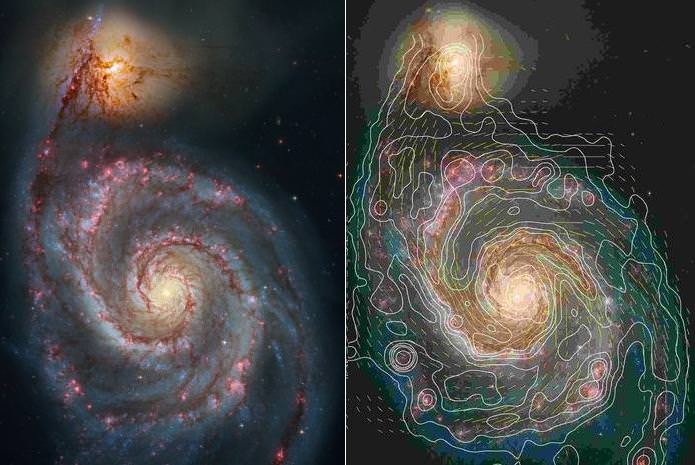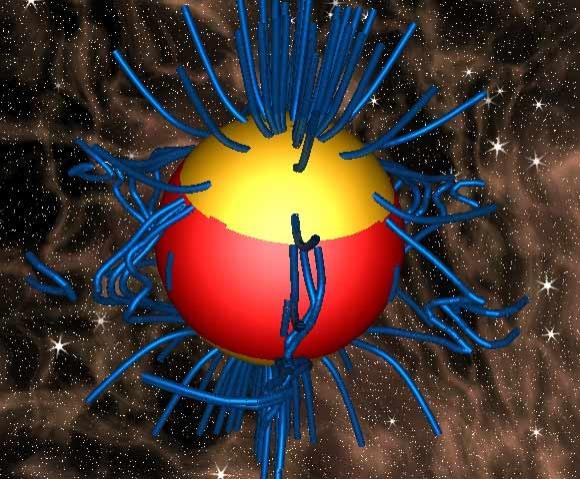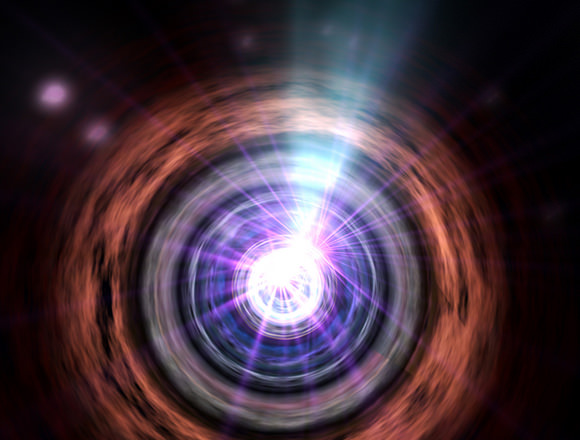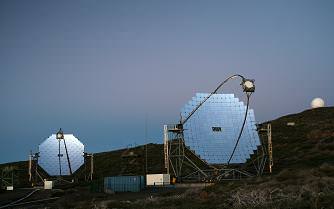[/caption]
The mention of cosmic-scale magnetic fields is still likely to met with an uncomfortable silence in some astronomical circles – and after a bit of foot-shuffling and throat-clearing, the discussion will be moved on to safer topics. But look, they’re out there. They probably do play a role in galaxy evolution, if not galaxy formation – and are certainly a feature of the interstellar medium and the intergalactic medium.
It is expected that the next generation of radio telescopes, such as LOFAR (Low Frequency Array) and the SKA (Square Kilometre Array), will make it possible to map these fields in unprecedented detail – so even if it turns out that cosmic magnetic fields only play a trivial role in large-scale cosmology – it’s at least worth having a look.
At the stellar level, magnetic fields play a key role in star formation, by enabling a protostar to unload angular momentum. Essentially, the protostar’s spin is slowed by magnetic drag against the surrounding accretion disk – which allows the protostar to keep drawing in more mass without spinning itself apart.
At the galactic level, accretion disks around stellar-sized black holes create jets that inject hot ionised material into the interstellar medium – while central supermassive black holes may create jets that inject such material into the intergalactic medium.
Within galaxies, ‘seed’ magnetic fields may arise from the turbulent flow of ionised material, perhaps further stirred up by supernova explosions. In disk galaxies, such seed fields may then be further amplified by a dynamo effect arising from being drawn into the rotational flow of the whole galaxy. Such galactic scale magnetic fields are often seen forming spiral patterns across a disk galaxy, as well as showing some vertical structure within a galactic halo.
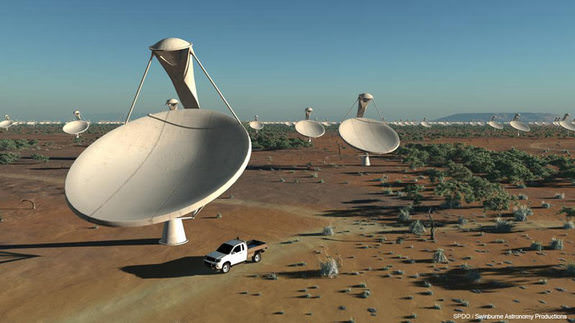
Similar seed fields may arise in the intergalactic medium – or at least the intracluster medium. It’s not clear whether the great voids between galactic clusters would contain a sufficient density of charged particles to generate significant magnetic fields.
Seed fields in the intracluster medium might be amplified by a degree of turbulent flow driven by supermassive black hole jets but, in the absence of more data, we might assume that such fields maybe more diffuse and disorganised that those seen within galaxies.
The strength of intracluster magnetic fields averages around 3 x 10-6 gauss (G), which isn’t a lot. The Earth’s magnetic fields averages around 0.5 G and a refrigerator magnet is about 50 G. Nonetheless, these intracluster fields offer the opportunity to trace back past interactions between galaxies or clusters (e.g. collisions or mergers) – and perhaps to determine what role magnetic fields played in the early universe, particularly with respect to the formation of the first stars and galaxies.
Magnetic fields can be indirectly identified through a variety of phenomena:
• Optical light is partly polarised by the presence of dust grains which are drawn into a particular orientation by a magnetic field and then only let through light in a certain plane.
• At a larger scale, Faraday rotation comes into play, where the plane of already polarised light is rotated in the presence of a magnetic field.
• There’s also Zeeman splitting, where spectral lines – which normally identify the presence of elements such as hydrogen – may become split in light that has passed through a magnetic field.
Wide angle or all-sky surveys of synchrotron radiation sources (e.g. pulsars and blazars) allow measurement of a grid of data points, which may undergo Faraday rotation as a result of magnetic fields at the intergalactic or intracluster scale. It is anticipated the high resolution offered by the SKA will enable observations of magnetic fields in the early universe back to a redshift of about z =5, which gives you a view of the universe as it was about 12 billion years ago.
Further reading: Beck, R. Cosmic Magnetic Fields: Observations and Prospects.

